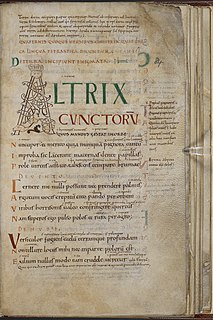Related Research Articles

Bede, also known as Saint Bede, The Venerable Bede, and Bede the Venerable, was an English Benedictine monk at the monastery of St. Peter and its companion monastery of St. Paul in the Kingdom of Northumbria of the Angles.

Northumbria was an early medieval Anglo-Saxon kingdom in what is now Northern England and south-east Scotland.

Aldhelm, Abbot of Malmesbury Abbey, Bishop of Sherborne, and a writer and scholar of Latin poetry, was born before the middle of the 7th century. He is said to have been the son of Kenten, who was of the royal house of Wessex. He was certainly not, as his early biographer Faritius asserts, the brother of King Ine. After his death he was venerated as a saint, his feast day being the day of his death, 25 May.
Wilfrid was an English bishop and saint. Born a Northumbrian noble, he entered religious life as a teenager and studied at Lindisfarne, at Canterbury, in Gaul, and at Rome; he returned to Northumbria in about 660, and became the abbot of a newly founded monastery at Ripon. In 664 Wilfrid acted as spokesman for the Roman position at the Synod of Whitby, and became famous for his speech advocating that the Roman method for calculating the date of Easter should be adopted. His success prompted the king's son, Alhfrith, to appoint him Bishop of Northumbria. Wilfrid chose to be consecrated in Gaul because of the lack of what he considered to be validly consecrated bishops in England at that time. During Wilfrid's absence Alhfrith seems to have led an unsuccessful revolt against his father, Oswiu, leaving a question mark over Wilfrid's appointment as bishop. Before Wilfrid's return Oswiu had appointed Ceadda in his place, resulting in Wilfrid's retirement to Ripon for a few years following his arrival back in Northumbria.

Benedict Biscop, also known as Biscop Baducing, was an Anglo-Saxon abbot and founder of Monkwearmouth-Jarrow Priory and was considered a saint after his death.

Aldfrith was king of Northumbria from 685 until his death. He is described by early writers such as Bede, Alcuin and Stephen of Ripon as a man of great learning. Some of his works and some letters written to him survive. His reign was relatively peaceful, marred only by disputes with Bishop Wilfrid, a major figure in the early Northumbrian church.

The Ecclesiastical History of the English People, written by the Venerable Bede in about AD 731, is a history of the Christian Churches in England, and of England generally; its main focus is on the conflict between the pre-Schism Roman Rite and Celtic Christianity. It was originally composed in Latin, and is considered one of the most important original references on Anglo-Saxon history and has played a key role in the development of an English national identity. It is believed to have been completed in 731 when Bede was approximately 59 years old.

Saint Ceolfrid was an Anglo-Saxon Christian abbot and saint. He is best known as the warden of Bede from the age of seven until his death in 716. He was the Abbot of Monkwearmouth-Jarrow Abbey, and a major contributor to the project to produce the Codex Amiatinus Bible. He died in Burgundy while en route to deliver a copy of the codex to Pope Gregory II in Rome.

The Codex Amiatinus is the earliest surviving complete manuscript of the Latin Vulgate version of the Christian Bible. It was produced around 700 in the north-east of England, at the Benedictine monastery of Monkwearmouth–Jarrow in the Anglo-Saxon Kingdom of Northumbria, now South Tyneside and taken to Italy as a gift for Pope Gregory II in 716. It was one of three giant single-volume Bibles then made at Monkwearmouth–Jarrow, and is the earliest complete one-volume Latin Bible to survive, only the León palimpsest being older; and the oldest Bible where all the Books of the Bible present what would be their Vulgate texts.

Ecgbert was an 8th-century cleric who established the archdiocese of York in 735. In 737, Ecgbert's brother became king of Northumbria and the two siblings worked together on ecclesiastical issues. Ecgbert was a correspondent of Bede and Boniface and the author of a legal code for his clergy. Other works have been ascribed to him, although the attribution is doubted by modern scholars.

Tatwine was the tenth Archbishop of Canterbury from 731 to 734. Prior to becoming archbishop, he was a monk and abbot of a Benedictine monastery. Besides his ecclesiastical career, Tatwine was a writer, and riddles he composed survive. Another work he composed was on the grammar of the Latin language, which was aimed at advanced students of that language. He was subsequently considered a saint.
Trumbert was a monk of Jarrow, a disciple of Chad and later Bishop of Hexham.
James the Deacon was a Roman deacon who accompanied Paulinus of York on his mission to Northumbria. He was a member of the Gregorian mission which went to England to Christianise the Anglo-Saxons from their native Anglo-Saxon paganism, although when he arrived in England is unknown. After Paulinus left Northumbria, James stayed near Lincoln and continued his missionary efforts, dying sometime after 671 according to the medieval chronicler Bede.
Gilling Abbey was a medieval Anglo-Saxon monastery established in Yorkshire, England.

The Abbey Church of Saint Peter and Saint Paul, Monkwearmouth–Jarrow, known simply as Monkwearmouth–Jarrow Abbey, was a Benedictine double monastery in the Kingdom of Northumbria, England.

Anglo-Saxon riddles are a significant genre of Anglo-Saxon literature. The riddle was a major, prestigious literary form in early medieval England, and riddles were written both in Latin and Old English verse. The pre-eminent composer of Latin riddles in early medieval England was Aldhelm, while the Old English verse riddles found in the tenth-century Exeter Book include some of the most famous Old English poems.
De creatura is an 83-line Latin polystichic poem by the seventh- to eighth-century Anglo-Saxon poet Aldhelm and an important text among Anglo-Saxon riddles. The poem seeks to express the wondrous diversity of creation, usually by drawing vivid contrasts between different natural phenomena, one of which is usually physically higher and more magnificent, and one of which is usually physically lower and more mundane.

St Paul's Church, Jarrow, is a Church of England parish church in the Parish of Jarrow and Simonside. It was founded in AD681 as a part of the Monkwearmouth–Jarrow Abbey. Most of the church is later but the chancel, is the remains of a free-standing chapel, of the monastery. On an inner wall of the tower is a dedication stone dating to 23 April AD 685 making this one of, if not, the oldest church dedication stone in England. It is dedicated to St Paul on 15th year of King Ecgfrith and in the 4th year of the Abbot Ceolfrith. The remains and markers for some of the later (medieval) abbey can be found in the church ground. The nave and the north aisle were built by Sir George Gilbert Scott. There is, in addition to a few pieces of old, including a few pieces of Anglo-Saxon stained glass, a more modern window by John Piper (1903-92).The church also has on display Bede’s Chair.

The Epistola ad Acircium, sive Liber de septenario, et de metris, aenigmatibus ac pedum regulis is a Latin treatise by the West-Saxon scholar Aldhelm. It is dedicated to one Acircius, understood to be King Aldfrith of Northumbria. It was a seminal text in the development of riddles as a literary form in medieval England.

The Enigmata Eusebii are a collection of sixty Latin, hexametrical riddles composed in early medieval England, probably in the eighth century.
References
- ↑ Mercedes Salvador-Bello, 'Patterns of Compilation in Anglo-Latin Enigmata and the Evidence of A Source-Collection in Riddles 1-40 of the Exeter Book, Viator, 43 (2012), 339–374 (p. 340 n. 3). 10.1484/J.VIATOR.1.102554.
- ↑ Talbot, C. H. (1954). The Anglo-Saxon Missionaries in Germany, Being the Lives of SS. Willibrord, Boniface, Leoba and Lebuin together with the Hodoepericon of St. Willibald and a selection from the correspondence of St. Boniface. London and New York: Sheed and Ward.
- ↑ Mercedes Salvador-Bello, 'Patterns of Compilation in Anglo-Latin Enigmata and the Evidence of A Source-Collection in Riddles 1-40 of the Exeter Book, Viator, 43 (2012), 339–374 (p. 340 n. 3). 10.1484/J.VIATOR.1.102554.
- Bede, Lives of the Abbots of Wearmouth and Jarrow in Webb and Farmer (eds & trs), The Age of Bede. London: Penguin, 1998. ISBN 0-14-044727-X
- Lapidge, M., "Hwaetberht", in M. Lapidge et al., The Blackwell Encyclopedia of Anglo-Saxon England. Blackwell, 1999. ISBN 0-631-22492-0
- Bede, Lives of the Abbots of Wearmouth and Jarrow